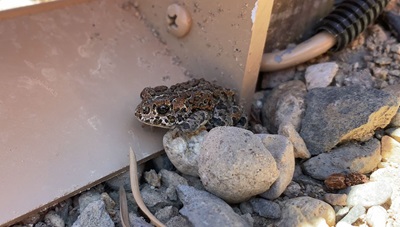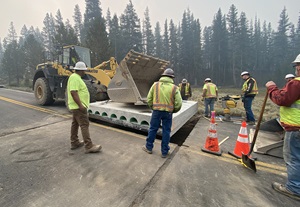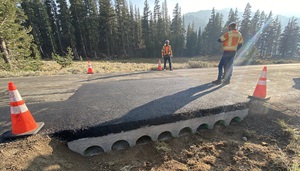A Yosemite toad negotiates its way about human-made structures near State Route 108. 
By Joe Reidhead
District 9 public information officer
Along State Route 108 in Mono County lies the remote Upper Sardine Meadow. Rushes and sedges dominate this 2-acre wetland complex at 9,100 feet in elevation, while sagebrush and lodgepole pine frame its edges.
Meadow residents include black bears, mule deer, red foxes and various species of rodents, birds and amphibians. Passing drivers can take in this unique habitat from nearby Sonora Pass – the second-highest paved crossing in California at 9,624 feet and a waypoint for hikers on the Pacific Crest Trail.
Hidden among the knee-high flora of this meadow is a community of Yosemite toads, toadlets and tadpoles. The meadow is home to one of the largest populations of breeding Yosemite toads within the Humboldt-Toiyabe National Forest.
The species is found only above 7,700 feet in elevation and within a 150-mile range of California’s Sierra Nevada, from Fresno County to Alpine County. Juveniles are the size of a grape, and the largest females are the size of a tangerine. Dark spots cover the toads’ bumpy skin, with yellow, orange and green hues filling the gaps.
Studies have demonstrated that the Yosemite toad has suffered a range-wide population loss and has declined or disappeared from over 50 percent of its known habitat. Due to its dwindling numbers, the U.S. Fish & Wildlife Service (USFWS) listed the toad as a threatened species under the Federal Endangered Species Act in 2014.
The Project
In 2016, biologists with the Humboldt-Toiyabe National Forest initiated mark and recapture surveys to track Yosemite toad populations along State Route 108 in Mono County. During their first survey, they noticed a problem at Upper Sardine Meadow, a federally designated critical habitat for the Yosemite toad.
Adult and juvenile toads regularly cross the road during the breeding season and winter migration. “Immediately, we noticed a lot of amphibian carnage along the road in Upper Sardine Meadow,” said Rachel Van Horne, one of the Forest Service biologists. “Every day we went up to survey, we saw fresh carcasses on the road.”
An opportunity to reduce toad mortality arose in 2018 when the District 9 Caltrans Highway Maintenance Unit programmed a routine repaving project for this section of SR-108.
“From the project’s inception, our staff began communicating and consulting with the USFWS on potential mitigation strategies for the Yosemite toad,” said Dannique Aalbu, the Caltrans biologist for the project.
Caltrans maintenance staff and biologists observed that some toads kept trying to use an existing drop-inlet drainage culvert. However, the culvert design did not accommodate amphibians. A vertical drop into the uphill side of the culvert caused toads to get stuck and expend valuable energy trying to pass through it.
The nearby Sonora Junction Maintenance Crew created a toad entrance and exit ramp for the culvert, which did alleviate the problem of falling and trapped toads. However, only a limited area of the meadow benefited from the alteration.
“We started thinking about how to add a toad-specific crossing into the maintenance project,” said Katie Rodriguez, biology branch chief for District 9. “Our district is always on the lookout for opportunities to add wildlife-friendly infrastructure appropriate to ongoing projects. Including it in an existing project is much cheaper than doing a separate project specifically for a wildlife crossing.
“We’ve made huge strides in developing and implementing a framework to identify and address wildlife connectivity issues around our roads.
“Additionally, District 9 staff thought the crossing structures could serve as a partnership-building opportunity and an innovative solution to a roadkill hotspot along this stretch of highway,” added Aalbu.
Early on, Caltrans formed a working group that included USFWS, United States Forest Service (USFS), United States Geological Survey (USGS), and American Rivers. These partners had the subject area and research expertise to ensure the project would have long-lasting benefits. Further, the partners could seek funding opportunities to support research into the effectiveness of the structures.
Caltrans biologists also collaborated with design engineers to create two low-cost experimental crossing structures that would be incorporated into the paving project. The first undercrossing is a standard cattleguard with one modification: no side wings (and no corresponding livestock fence). The second undercrossing includes two sets of eight 6-inch-wide halfpipe culverts placed in a concrete slab.
When construction started in the summer of 2020, the crossings were pre-fabricated off-site and dropped into the road. The structures are 50 feet away from each other, the ideal spacing to provide small wildlife with convenient, stress-free crossing opportunities.
A critical feature of any wildlife crossing is an exclusionary fence. Caltrans’ environmental and maintenance staff worked together to install the 18-inch-high and 6-inch-deep Animex wildlife fence to funnel toads and other small creatures into the undercrossings.
To avoid accidental take and accommodate equipment needs and weather, they installed the fence just before the winter closure of Sonora Pass in 2021. The solid plastic amphibian-specific fence extends 50 feet beyond each crossing. It includes standard features such as turnarounds at the terminal ends and jumpouts (one-way off-ramps from the road to the meadow) in case a wayward toad finds itself on the road.
The fences and crossings create a 170-foot-long barrier on either side of the road. Though this length does not cover the entire meadow, it created a wildlife barrier in the main wetland corridor where most roadkill occurred.
When the toads entered winter hibernation, Caltrans and its partners finalized their plan for measuring the effectiveness of the structures. The trickiest task would involve gathering reliable data on these small amphibians and their use of the crossings.
The Research
“A juvenile is entering the crossing,” exclaimed Aalbu. Along with Whitney Philbrook, another Caltrans biologist, Aalbu was on site to replace camera batteries and exchange memory cards. A yard behind her, tadpoles squiggled in a 3-inch deep puddle of water amidst the meadow’s rushes.
The toad quickly disappeared into the halfpipe crossing. Toads don’t hop; they crawl. The juvenile made swift progress and crossed under half the road’s width within a minute.
Existing research into the crossing preferences and habits of Yosemite toads is limited, but the new crossings presented a unique opportunity to conduct original research and answer several questions, including:
Do the toads use the crossings, including females, males, adults and juveniles?
Do the structures and fencing reduce toad roadkill?
Do the toads prefer one style of structure over the other?
Does other wildlife use the crossings?
“Some studies have suggested that light may trigger Yosemite toad activity and movement,” Aalbu explained, “so the cattleguard is considered likely beneficial because light during the daytime shines completely through.”
The partners needed to track and analyze the toads’ movements to answer these questions. However, collecting accurate movement data on such small creatures with off-the-shelf wildlife tracking products is difficult.

Crews insert the toad crossing structure into State Route 108.
Photo by District 9Most wildlife tracking cameras used by researchers rely on passive infrared (PIR) triggers, which detect mammals through a combination of heat and motion. PIR cameras can accurately capture large and medium-sized mammals and are regularly used in Caltrans monitoring projects. Unfortunately, PIR lacks the precision and sensitivity to detect ectotherms (amphibians, reptiles, and invertebrates) and small mammals such as voles. The District 9 team knew that their standard wildlife cameras would not be capable of reliably capturing toad movement. So they reached out to Cheryl Brehme, their partner at the USGS and a wildlife crossing specialist.
“Cheryl has been instrumental as a knowledge base for us in how to monitor the use of the structures,” Aalbu said. “She put us in touch with San Jose-based Hobbs Ecology. Hobbs manufactures specialized wildlife cameras to capture the movements of small animals.”
Michael Hobbs came to the world of wildlife monitoring after a career as a Navy pilot. A concern for threatened and endangered species inspired him to design data capture solutions for otherwise overlooked species. Seeing the limits of PIR cameras, Hobbs developed a new trigger, the patented Hobbs Active Light Trigger (HALT). The HALT uses a near-infrared (NIR) optical trigger integrated into a threshold that fits the opening width of the wildlife crossing. The height of the NIR beam is also set to the size of the targeted wildlife.
A team member visited the site every two weeks for the duration of the 2022 pilot study, which extended from May until September. First, they counted and recorded the location of any toad roadkill. This information went into the site study and the District 9 roadkill database. They also troubleshot any video issues, swapped the memory cards in the cameras, and replaced the rechargeable lithium-ion batteries.

Now that it’s installed, toads have a safe option to cross the roadway.
Photo by District 9At the meadow, the Caltrans biologists were able to observe toads on several occasions using the crossings. Each time, the toads crossed through the invisible 3mm NIR beam and triggered the camera to start filming. The camera is a standard PIR wildlife camera reprogrammed to accept the Hobbes trigger.
It is too early to know whether the structures benefit the toads. Researchers at the USGS will process the data from the 2022 pilot study during the upcoming winter season. As with other wildlife crossings, the toad crossings may also benefit other species. Montane voles, ground squirrels, deer mice, and shrews have all been caught on camera using the crossings.
“Currently, there are no standard crossing structure plans for Yosemite toads. If the research proves the structures effective, we hope to develop standard plans for use on other California roads with adjacent Yosemite toad habitat,” Aalbu remarked.
The efforts in District 9 have already yielded benefits beyond the district. Rodriguez noted that District 9’s collaboration with external partners to develop potential low-cost strategies that improve connectivity and reduce roadkill had gained the attention of other Caltrans districts with protected amphibian species. “We hope the results of our study can improve connectivity for amphibians state-wide,” Rodriguez said.
The toad crossings in District 9 are evidence of Caltrans bringing forward efficient and innovative solutions through strategic partnerships to take on challenges large and small.

